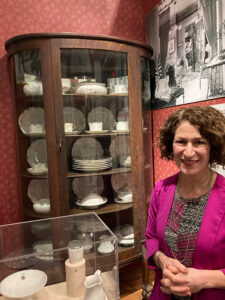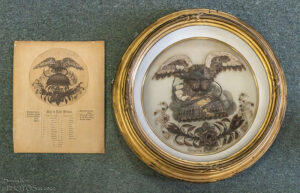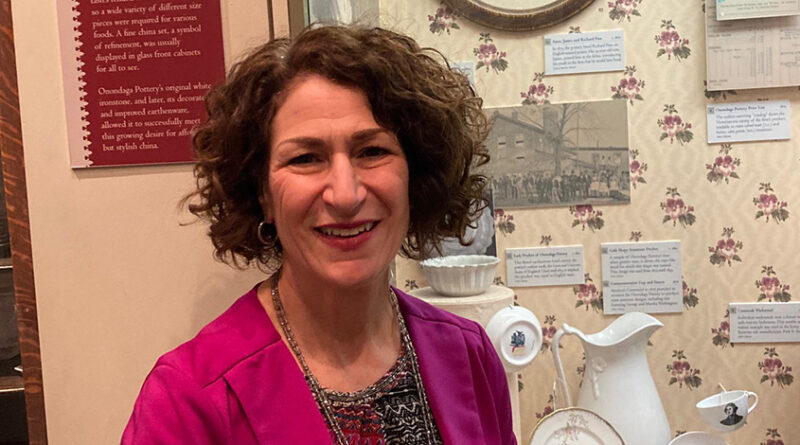Keepers of the Central New York History
One of the goals of Lisa Romano Moore, new director at Onondaga Historical Association, is to get more research materials digitized
By Mary Beth Roach

As the new executive director of the Onondaga Historical Association, Lisa Romano Moore and her 13-member staff are keepers of the Central New York history, dating back generations.
“We’re the collectors, the preservers, the interpreters of both Onondaga County and the city of Syracuse history,” Moore explained.
As such, she and her team oversee the management or maintenance of collections not only at the Onondaga Historical Museum in downtown Syracuse, but also the Skä•noñh — Great Law of Peace Center in Liverpool and the Brewseum at Heritage Hill in Jamesville. Moreover, displays, historical signage, and photos from the OHA are at the Syracuse Hancock Airport, along the Syracuse Creekwalk, the Military History Museum at the OnCenter War Memorial, and in various buildings downtown.
“Just how pervasive OHA is in the fabric of this community is hard to miss,” she said.
And too, these pieces and displays also underscore the vital role that Moore believes history plays in a community’s life.
“People love to remember what they consider the good old days, when they were kids and what their neighborhood was like,” she said.
But there’s also the importance of understanding the impact of things and events on our history and our experience, such as the issue of Interstate 81, she added.
It’s “a huge discussion right now and we’re documenting that and making sure that whenever, whatever 81 looks like in the next 25 years, those who follow us are going to have a sense of the conversation that was had around it,” she explained.
Her own history is rooted in Central New York.
She grew up in Auburn and her grandfather was a stone mason on Syracuse’s northside. He helped build the former GE plant in Liverpool and the smokestacks at Crucible in Solvay.
After serving as the OHA director of development for three years, Moore, 55, was selected in January as executive director, replacing Gregg Tripoli, who retired from that post at the end of 2022, having served since 2008. Tripoli has been credited with revitalizing the OHA and strengthening its role in the community.
In the three years that she worked with Tripoli, she said she was able to “see the cycle of events and activities and his priorities” and to get a sense of how to move forward.
Looking ahead, Moore plans to maintain “the things that people love about the OHA,” she said. “Just because you have a change in leadership doesn’t mean that everything’s going to be turned inside out and upside down.”
One of Moore’s plans in moving forward is to keep up with partnerships that Tripoli had developed during his tenure. That includes continuing to work with the Stickley House Foundation on renovating Gustav Stickley’s home on the city’s east side into a guest house with an arts and crafts style. Also, the discussion of the Columbus statute in downtown Syracuse and providing some historical perspective for Heritage Park, located across the street from the statue, she explained.
She also is planning an upgrade to the heating and ventilation in the OHA Museum downtown, providing better environmental controls to protect some of the museum’s more fragile artifacts, such as newspapers, some of which date back to the Civil War.
Another of her goals is to get more of their research materials digitized. For example, when local channels 3 and 5 consolidated to form CNYCentral, the OHA got about 7,000 newsreels of the nightly newscasts from the 1960s and ‘70s. She noted that in one, there was a discussion on school vouchers, which is still a conversation today, she said.
She would also like to do more in collecting and preserving generational materials, for example correspondence and items that were made in Syracuse. She told of receiving a collection of letters from a descendant of the Sedgwick family that were written from a young Civil War soldier to his wife-to-be and his mother. These “tell the story of where we came from,” she said.
Moore also emphasized that the OHA is much more than its exhibits and artifacts and unique gift shop. It is a resource for other museums and researchers worldwide.
Moore offered several examples.
Libba Cotten’s Grammy and guitar are on loan to the Rock and Roll Museum in Cleveland. Cotten was an award-winning folk and blues musician, who had lived for some time in Syracuse and died here.
Television host, legal commentator and author Dan Abrams did research at the OHA for the book, “Theodore Roosevelt for the Defense,” that he co-wrote, chronicling the famous libel trial held in the Onondaga County Courthouse in 1915 between Roosevelt and a former chairman of the Republican Party, William Barnes.
“It’s an amazing enterprise to see where our materials go, how they’re utilized,” Moore said.
She looks forward to several projects. In the fall, “Suit Up” will feature uniforms and other memorabilia from various professional and college teams from the Central New York community. Another one, which is probably two years away, has the working title of “The Way We Weren’t,” featuring strategies or plans that never quite made it off the drawing board. And due to come out at the end of the year will be a book that shares the stories of the magnificent mansions that once lined James Street and the people who lived there.
With thousands of artifacts to choose from, Moore found it fairly easy to identify what is probably the OHA’s most unique piece and her favorite collection.

One of the rarest, in her opinion, is called the “The Hairy Eagle.” She explained that there was a time during the Victorian era when heirlooms, like a ring or a broach, might contain a lock of a loved one’s hair. The “Hairy Eagle” goes well beyond that, though. The sculpture of an eagle was created, made out of Abraham Lincoln’s hair, along with tresses from his wife, Mary Todd Lincoln; and various members of the Lincoln Cabinet. The artwork was featured in a 2021 issue of Smithsonian Magazine. While the piece is housed on one of the upper floors of the museum, Moore admitted that due its fragile nature, it’s rarely on public display.
Her favorite —and one of the public’s too —is the extensive display of Syracuse China, located on the museum’s second floor. One might not consider dishes to be historical, but as Moore explained, it can evoke smells and sounds and memories of family gatherings.
“History is really personal. It’s their identity,” she said. “We’re living it all the time.”

